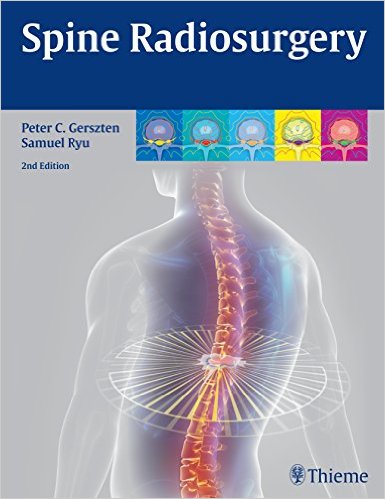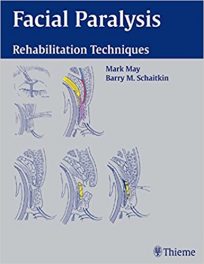 Editors: Peter C. Gerszten, MD; and Samuel Ryu, MD
Editors: Peter C. Gerszten, MD; and Samuel Ryu, MD
Publisher: Thieme – 203 pages
Book Review by: Nano Khilnani
Beaming ionizing radiation very precisely on small, targeted areas in the human body that are diseased (such as within the spine for example) is a relatively new means of treatment, to remove malignant tumors, relieve pain, and achieve other desired objectives.
This process developed when imaging technologies (such as angiography, computed tomography, magnetic resonance imaging) enabled surgeons to see targets that either became visible for the first time, or were more clearly visible, and with ample detail.
Essentially this is what ‘radiosurgery’ is. That term likely did not exist before 1951. In that year, neurosurgeon Larks Leksell, seeking less invasive and less morbid means for achieving better patient outcomes, submitted a paper on the subject to the editor of a scientific journal, who proclaimed to him that “there is no such thing as radiosurgery.”
Over the years, radiosurgery, as an alternative to traditional surgery that involves excision with a blade for example, has saved lives, eliminated disabilities, enabled movement and in general improved daily living for countless people. Radiosurgery has been used frequently on patients with diseases and disorders of the spine.
Seventy-eight specialists in various medical areas – brain pathology, dosimetry, medical physics, neurosurgery, radiation oncology, radiosurgery, spine surgery, and related fields – contributed to the content in this book’s 23 chapters listed below. The writers are from the United States and Canada, Germany, Israel, the Netherlands, South Korea, and Switzerland.
This book has over 100 full-color illustrations. This edition has six new chapters with coverage of such topics as discussion of new treatments for metastatic spine disease and spinal cord compression, histopathological examination of spinal lesions, minimally invasive techniques, and treatment of spinal chordomas. To give you a broad overview, we list below the five sections of this book, with the following chapters within them:
- Radiobiology
- Radiobiology of Radiosurgery
- Experimental Spinal Cord and Spinal Nerve Radiation Biology
- Clinical Spinal Cord Tolerance to Radiosurgery
- Management of Spinal Cord Toxicity
- Histopathologic Examination of Spinal Lesions after Radiosurgery
- Physics and Techniques
- Stereotactic Spine Radiotherapy: Image Guidance and Patient Immobilization
- Treatment Planning for Spine Radiosurgery
- Quality Assurance and Treatment Delivery
- Contemporary Devices for Spinal Radiosurgery
- Spine Metastases
- Imaging
- Radiosurgery for the Re-treatment of Progressive Spine Metastases
- Clinical Outcomes after Spinal Radiosurgery
- Clinical Outcomes of Pain and Quality of Life After Spinal Radiosurgery
- Radiosurgery for Spinal Canal Compromise and Spinal Cord Compression
- Postoperative Stereotactic Radiosurgery and Minimally Invasive Surgical Techniques
- Radiosurgery and Percutaneous Cement Augmentation
- Treatment Failure, Complications, and Their Management
- Patient Evaluation and Treatment Selection for Spinal Canal Compromise
- Primary Malignant and Benign Spinal Tumors
- Radiosurgery for Benign Extramedullary Tumors of the Spine
- Radiosurgical Treatment of Spinal Chordomas
- Role of Radiosurgery in Treatment of Primary Malignant Spine and Spinal Cord Tumors
- Radiosurgery for Spinal Cord Arteriovenous Malformations
- Integration of Spine Radiosurgery
- Multidisciplinary Approach for Evaluation and Treatment of Metastatic Spinal Tumors
What type of content will you find in this book? Let’s take a look at the outline of content in chapter 21, The Role of Radiosurgery in the Treatment of Primary Malignant Spine and Spinal Cord Tumors written by Drs. Moon-Jun Sohn, Dong-Joon Lee and Hye-Ran Lee. Here it is:
- Introduction: discusses the locations and characteristics of primary spinal tumors
- Review of the Current Therapeutic Modalities: Surgery, Chemotherapy
- Primary Malignant Spinal Column Tumors
- Principles of Surgical Treatment
- Chemotherapy: Osteosarcoma, Ewing Sarcoma, Chondrosarcoma, Multiple Myeloma
- Radiation Therapy
- Primary Malignant Spinal Cord Tumors
- The Role of Radiosurgery
- Primary Malignant Spinal Column Tumors
- Ewing Sarcoma
- Multiple Myeloma and Solitary Plasmacytoma
- Primary Malignant Spinal Cord Tumors
- Summary
- References
This is a good volume on spine radiosurgery. It contains discussions of the latest devices, patient selection, target definitions, treatment planning techniques, and much, much more.
Editors:
Peter C. Gerszten, MD is the Peter E. Sheptak Professor in the Departments of Surgery and Radiation Oncology at the University of Pittsburgh Medical Center in Pittsburgh, Pennsylvania.
Samuel Ryu, MD is Professor of Oncology and Neurosurgery, Chairman of the Department of Radiation Oncology, and Deputy Director of Stony Brook Cancer Center at Stony Brook University School of Medicine in Stony Brook, New York.







